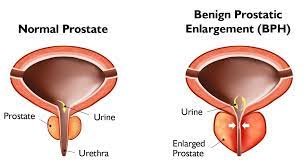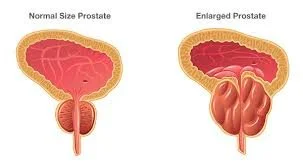prostate
Prostate Enlargement Benign Prostatic Hyperplasia (BPH)
The prostate is a small, walnut-sized gland located below the bladder in men. Its main job is to produce a fluid that nourishes and transports sperm during ejaculation. The prostate surrounds the urethra, the tube through which urine and semen exit the body. As men age, the prostate may enlarge, causing symptoms like difficulty urinating. Regular check-ups and discussions with your doctor are crucial for monitoring prostate health, as issues can arise. Understanding the role of the prostate helps maintain overall well-being and address any concerns early on.
prostate enlargement
As men age, it’s common for the prostate to enlarge, a condition known as Benign Prostatic Hyperplasia (BPH). Although this enlargement is a natural part of aging, it may lead to bothersome urinary symptoms, impacting quality of life. BPH is non-cancerous, with "benign" indicating non-cancerous cells and "hyperplasia" referring to increased cell numbers. Symptoms, such as frequent urination, weak urine flow, and the feeling of incomplete bladder emptying, may arise. While BPH isn't cancer, it can cause urinary difficulties due to the gland's enlargement, emphasizing the importance of monitoring symptoms and seeking timely medical attention.
BPH
Enlarged prostate may impair flow of urine out of bladder
the symptoms
Symptoms of BPH are rare before age 40 but affect over 50% of men in their sixties and up to 90% in their seventies and eighties.
Prostate enlargement in BPH squeezes the urethra, causing urinary issues.
Changes due to untreated enlargement may include thickening of the bladder wall, reduced bladder capacity, and increased irritability.
Frequent urination during the day and night may occur as the bladder weakens.
Urgent and sudden urges to urinate can lead to difficulty reaching the toilet in time.
Slow urine stream, straining to start urination, and dribbling after urination are common.
Sensation of incomplete bladder emptying and lack of force in urine flow are reported.
Struggling to begin urination, weak urine flow, and intermittent flow are typical symptoms.
Incomplete bladder emptying and frequent urination at night cause sleep disruption.
Seek immediate attention for less common symptoms like blood in urine, urinary retention, and painful urination.
enlarged prostate
causing difficulties in passing or holding urine
What happens after referral
After receiving your referral, our practice nurse will triage your case, and you'll be promptly contacted for a brief overview of your condition. Preceding your visit, several diagnostic tests, including PSA, urine analysis, ultrasound, and IPSS (prostate symptoms questionnaire), are arranged to enhance the evaluation. At your appointment, A/Prof Homi Zargar will engage with you, conduct a thorough assessment, and review the gathered information. A personalized care plan addressing your symptoms will be devised, ensuring all your questions are addressed.
Diagnosis of BPH involves:
A comprehensive symptom assessment through a detailed history.
Urologists conducting examinations and ordering additional investigations, including the IPSS questionnaire for diagnosis and treatment monitoring.
Midstream urine test to rule out infection or blood.
PSA blood test for additional diagnostic insights.
Renal tract ultrasound for prostate, bladder, and kidney evaluation.
Flow rate measurement to assess urine flow and bladder emptying.
Flexible cystoscopy(in the office in selected cases) for detailed evaluation if necessary.
Treatment options
Individualized Approach: Recognizing the uniqueness of each case, A/Prof Homi Zargar tailors treatments specifically for your conditions and symptoms arising from benign prostatic hyperplasia (BPH).
Diverse Solutions: We provide an array of medical and surgical treatments, understanding that enlarged prostates vary, steering clear of a uniform approach.
Medical Therapy:
Alpha Blockers: Ease symptoms by relaxing the bladder, neck, and prostate, with minor potential side effects.
5A-reductase Inhibitors: Reduce prostate size with potential side effects like decreased libido and erectile dysfunction.
Combination Therapy: (of the above) More effective together, reaching peak efficacy in 6-9 months.
Mirabegron: A beta-3 adrenoceptor agonist added to reduce symptoms of bladder overactivity.
Anticholinergics: Employed to alleviate symptoms of bladder overactivity.
Non-Surgical Treatments:
Watchful waiting and lifestyle management, utilizing strategies like fluid management, medication adjustments, new medications, and pelvic physiotherapy.
Surgical Treatments:
Considered if conservative approaches prove unsuccessful, with discussions about necessity and potential benefits.
Surgical therapy stands as a permanent solution for addressing symptoms arising from BPH. While medical therapy helps alleviate symptoms, it lacks permanence, and the disease may progress during its course. Notably, definitive surgical interventions, such as those improving urine flow, demonstrate significantly superior symptom improvement compared to medications. The goal of surgery is to restore urethral caliber, reducing bladder workload and enhancing flow by minimizing resistance. Additionally, ongoing medication use (beyond 2 years) raises potential concerns about long-term effects.
In broad terms, surgical treatment options can be categorized into two main groups: Minimally Invasive Surgical Treatment (MIST) and Cavitating Prostate Surgery. This field in urology is rapidly evolving, with various techniques and technologies available. Below are outlines of some of the options.
Minimally Invasive Surgical Treatment (MIST)
Rezūm Therapy
The Rezūm procedure involves inserting a telescope through your urethra and introducing steam into the obstructing prostate tissue surrounding it.
Over the subsequent 3-6 months, the prostate tissue gradually contracts.
The aim is to enhance urinary symptoms without resorting to the burning or removal of any prostate tissue.
Typically performed as a day-case procedure, a bladder catheter is required for seven days post-operation.
Sexual side-effects such as erectile dysfunction (impotence) are exceptionally rare, and retrograde (dry) ejaculation is also infrequent.
In a small number of men, additional treatment may be necessary at a later stage.
Read more about Rezum.
Urolift® System
The Urolift® procedure involves utilizing a telescope through your urethra and inserting two to four (or more) implants into your prostate to displace the obstructing tissue from your urethra.
Its purpose is to enhance urinary flow without the necessity of burning or removing any prostate tissue.
Typically, a catheter is not required after this procedure.
Sexual side-effects like retrograde (dry) ejaculation or erectile dysfunction (impotence) are exceedingly rare.
A small number of men undergoing this surgery may necessitate further treatment at a later stage.
Read more about Urolift.
Clinical trials (involving different procedures and devices)
Surgery
Bladder Neck Incision (BNI)
BNI involves creating a cut in the bladder neck using an energy source (electric or laser) passed through a telescope along the urethra.
After the procedure, a temporary catheter will be placed in the bladder for temporary urine drainage.
BNI is highly effective in addressing symptoms related to bladder outflow obstruction.
Approximately 4 out of 10 men may experience retrograde ejaculation afterward, leading to "dry" orgasms.
Read more about BNI.
Transurethral Resection of Prostate (TURP)
TURP entails removing a portion of your prostate gland to enhance urine flow.
TURP is the most frequently conducted procedure to enhance urine flow, providing effective relief for most men experiencing symptoms.
Following the operation, a bladder catheter is temporarily utilized to flush out blood clots.
Common post-operative effects include the permanant inability to release semen during ejaculation and short-term occurrences of bleeding, burning sensation, or increased urinary frequency.
Read more about TURP.
Holmium Laser Enucleation of the Prostate (HoLEP)
HoLEP includes the removal of obstructive prostate tissue using a laser fiber passed through a telescope inserted via the penis.
HoLEP proves highly effective in enhancing urinary symptoms associated with bladder outflow obstruction, particularly for men experiencing urine retention and relying on a urinary catheter.
Following the procedure, a bladder catheter will be in place for 24 to 72 hours to flush out any blood clots.
Common post-operative effects include a loss of emission during ejaculation and short-term experiences of bleeding, burning sensations, or increased urinary frequency.
Read more about HoLEP.
Greenlight laser ablation of Prostate
Green Light Laser Prostatectomy, also known as photoselective vaporization of the prostate (PVP), involves removing obstructing prostate tissue using a laser fiber passed through a telescope along your urethra.
The outcome is a broad, open channel for urine flow through the prostate, accompanied by reduced bleeding and an earlier hospital discharge compared to TURP.
Many of these procedures are conducted as day cases, and typically, the catheter is removed within 72 hours.
Common side effects include a temporary inability to ejaculate semen, a burning sensation during urination, and increased urinary frequency.
Robotic Simple Prostatectomy (RASP)
Robotic Simple Prostatectomy is a surgical procedure designed to eliminate the central obstructing lobes of the prostate while preserving the outer shell and capsule.
This procedure offers enhanced precision and dexterity, conducted with a robot, contributing to a more refined and minimally invasive approach.
The operation concludes with placing a catheter, which remains in place for six days.
This procedure is reserved for large prostate glands.
Read more about RASP.




